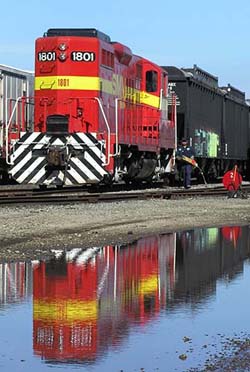California joins the state short-line funding crowd
2/22/2021
By Jeff Stagl, Managing Editor
For many decades, California has provided grants and other funding for freight- and passenger-rail projects. But the state only recently began providing funds for short-line projects.
In January, the California Transportation Commission (CTC) issued the first-ever grants under the state’s new Short-Line Railroad Improvement Program. Enacted in mid-2019, Senate Bill 87 called for the program’s creation. The legislation was championed by California Sen. Melissa Hurtado in part so short lines could upgrade their aging infrastructure and handle heavier rail cars.
The two-year, $7.2 million Short-Line Railroad Improvement Program (funded for fiscal years 2020-21 and 2021-22) aims to fund infrastructure improvement projects that help regionals and short lines improve freight mobility, efficiency, reliability, sustainability, safety and load capacity.
“The program is the first of its kind in California,” says Alicia Sequeira, the CTC’s assistant deputy director. “We developed the guidelines and processes for the program.”
Adopted at a June 2020 CTC meeting, those guidelines describe the policies, standards, criteria and procedures for the program’s development, adoption and management. The CTC received project nominations on Dec. 1, then selected seven applicants seeking $6.45 million in funding.
Commission staff recommended that the remaining $750,015 be transferred to the state’s trade corridor enhancement account since that amount wasn’t large enough to be distributed among several other short-line projects, says Sequeira.
The selected projects and their state funding share are:
• The $3.6 million Stockton Intermodal Transload and Alternative Fuel Project, which will receive $1.8 million for replacing 17,136 linear feet of rail and repairing 3.6 miles of rail;
• the $2.9 million Sonoma-Marin Area Rail Transit Freight Improvements Project, which will receive $1.45 million for repairing the Black Point Bridge over the Petaluma River, rehabilitating two existing freight spurs and constructing one freight spur;
• the $2.8 million Arizona & California Railroad Desert Rail Replacement Project, which will receive $1.4 million for replacing 3.8 miles of rail;
• the $1.4 million Sacramento Valley Railroad Capacity Expansion Project at McClellan Business Park, which will receive $664,000 for building two 1,311-foot-long tracks;
• The $866,000 Pit River Curves Track Rehabilitation in Modoc County, which will receive $433,000 for rehabilitating 1.25 miles of worn curve rail;
• the $800,000 Santa Maria Valley Railroad Track Rehabilitation Project, which will receive nearly $400,000 for replacing 1.6 miles of track with heavier rail; and
• the $670,000 Pajaro River Bridge Rehabilitation Project, which will receive $285,000 for rehabilitating a bridge on the Santa Cruz branch line.
The recommended projects address significant short-line needs by upgrading aging rail to modern standards, rehabilitating old rail bridges, restoring and constructing rail spurs, and building new track, according to the CTC.
 The nearly $400,000 in state funding will help the Santa Maria Valley Railroad replace 1.6 miles of older rail with heavier rail. Credit: Santa Maria Valley Railroad
The nearly $400,000 in state funding will help the Santa Maria Valley Railroad replace 1.6 miles of older rail with heavier rail. Credit: Santa Maria Valley RailroadThe projects also promise a variety of benefits to the state, including increased throughput, better goods movement, less congestion and air pollution, fewer truck miles traveled, greater safety and improved rail operations, says Sequeira. For example, the work is projected to reduce daily truck trips by more than 15,000, daily truck miles by more than 111,000 and greenhouse-gas emissions by more than 2 million tons over the next 15 years.
The CTC expects at least two of the applicants to request their state funds at the commission’s March meeting.
“We need to know about any requests by March 12,” says Sequeira.
Because the program does not have a continuous funding source, the state would need to provide more funds for it after FY2021-22 to support more short-line projects, she says.
Since the state never had a dedicated short-line funding source, there was quite the learning curve the CTC needed to navigate to get the program going. The commission sought help from various constituents and from some of the other states that long have offered short-line funding programs, says Sequeira. Among those states: Iowa, Kansas, Kentucky, Mississippi, North Carolina, New Jersey, Pennsylvania, Tennessee and Wisconsin.
“We have learned a lot through this process, such as what to expect next time,” says Sequeira.


